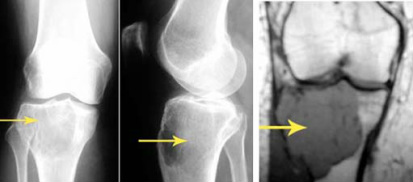Click to set custom HTML
Pathology definition - Giant Cell Tumor
 Arrows indicate the present of giant cell tumor
Arrows indicate the present of giant cell tumor
Giant Cell Tumor
Giant cell tumor may affect the epiphyses of the long bone at the proximal tibia or distal femur. Giant cell tumor mostly affect the areas of the knee. There will be osteoclast giant cells and fibrous stroma. There will be a lot mitoses of the oval mononuclear cells.
Giant cell tumor may arise as benign tumor of the monocytes. Patient may complain of pain in joint and fracture of the bone. Giant cell tumor may not turn to malignant. However, giant cell tumor may recur after treatment and it is aggressive in nature.
Giant cell tumor may present as cystic degeneration ( red and brown in color) or hemorrhagic or necrotic lesions. Radiography imaging may reveal the soap bubble appearance.
The treatment may focus on surgical removal of the giant cell tumor.
Giant cell tumor may affect the epiphyses of the long bone at the proximal tibia or distal femur. Giant cell tumor mostly affect the areas of the knee. There will be osteoclast giant cells and fibrous stroma. There will be a lot mitoses of the oval mononuclear cells.
Giant cell tumor may arise as benign tumor of the monocytes. Patient may complain of pain in joint and fracture of the bone. Giant cell tumor may not turn to malignant. However, giant cell tumor may recur after treatment and it is aggressive in nature.
Giant cell tumor may present as cystic degeneration ( red and brown in color) or hemorrhagic or necrotic lesions. Radiography imaging may reveal the soap bubble appearance.
The treatment may focus on surgical removal of the giant cell tumor.
